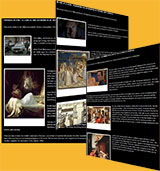Article Stats
This Millennium article has been viewed 33556 times.
It was last viewed on Sunday, April 21, 2024, 12:45 AM (UTC).
Episode Profile
Episode Title:
MLM Code:
#MLM-100
Production Code:
4C79
Season:
1
Original Airdate:
1996-10-25
Episode Summary
A vicious serial killer is on the loose in Seattle, roaming strip clubs and gay hang-outs, believing he is on a mission to cleanse the plague-infested city from sin in preparation for the apocalypse. At the same time, renowned FBI profiler Frank Black retires to Seattle with his family as he gains membership in the secretive Millennium Group. He soon realizes that he must be the one to bring closure to the so-called Frenchman's grotesque crimes, before further innocents are brutally killed.
Main Crew
Written by Chris Carter
Directed by David Nutter
Edited by Stephen Mark
Random scenes from Pilot
There are a total of 130 images for Pilot which are available in our Episode Image Gallery.
Awards and Nominations
People's Choice Award 1996:
Millennium - Best new television dramatic Series (Winner)
American Society of Cinematographers Award:
Pete Wunstorf - Outstanding Achievement in Cinematography in a Pilot (Nominee)
Written In The Stars - An explanation of the Millennium DVD Menu Image
Written In The Stars
Mysterious symbols are associated with Millennium both within its episodes and on the visual identity given to the show‘ logo and associated merchandise. The most notable of these is the Ouroboros, the alchemical symbol of self-reflexivity or cyclicality, but runes and symbols can also been seen as faint watermarks in the background of the show‘ titles screen and a curious map or chart is evident on the DVD menu screen of all the three seasons of the show.
This brief article is the result of our attempts to identify that strange chart of symbols and identify why it was chosen to reflect the thematic of the show in the look of the DVD releases. We were able to deduce that the chart is chart of the heavens, well over a millennia old, known as The Suchow Planisphere.
The Suchow (Soochow/Su-chou) Planisphere
The word planisphere (or "planisferium") means "celestial plane" as is defined as the flat plane representation of the star-filled sky. The instrument was first described in the early 11th century by the Persian astronomer, AbÅ« RayhÄn and it was a century later when The Suchow Planisphere came into existence.
In 1193, the astronomer Huang Shang prepared a planisphere along with explanatory text to accompany it. The planisphere itself depicts numerous unequally spaced radial grids shown correspond to the boundaries of the Chinese lunar mansions. Both the planisphere and its explanatory text were prepared by Huang Shang for the instruction of the heir to the Chinese throne, who ruled as Emperor Ning Tsung (1195-1224 CE).
The planisphere was carved onto stone (to preserve it) approximately half a century later, in 1247 CE (Southern Song dynasty, Chunyou reign), by Wang Chih-Yuan. What is of interst is the detail contained within the planisphere itself. Most of the stars in the Chinese sky are carved quite precisely upon it and also recorded is the supernova of 1054 CE (in Taurus).
For a long time the stele on which the planisphere was carved was located in the Wên Miao Temple (Confucian Temple of Literati), originally built in 1141 CE, in the historic garden city of Suzhou in the south of Jiangsu Province. The planisphere is now housed in a Suchow Museum (the Stone Carving Museum).
Although only 10 rubbings of the stele were made they remain in existence and it was one of these rubbings that was used as the source image for the mysterious chart that adorns the Millennium DVD menu screens.
There seems to be nothing particularly fitting about the use of that image on the DVD menus. There is scant information out there with regards to Huang Shang and little to separate him from other astronomers of his time. The year the planisphere was created does not yield a particularly momentous stellar configuration or event that might hint at why it was chosen nor was there anything notable in terms of movements within world religion or politics that year that might provide further clues to it use.
Though it is impossible to say I am forced to conclude that the image was selected merely for its aesthetic appeal rather than any occult reference that might link it to the thematics of Millennium.
 The The Suchow (Soochow/Su-chou) Planisphere superimposed over the Millennium DVD Menu is a complete match.
The menu is © Copyright Twentieth Century Fox Home Entertainment, Inc and its related entities. All Rights Reserved.
The The Suchow (Soochow/Su-chou) Planisphere superimposed over the Millennium DVD Menu is a complete match.
The menu is © Copyright Twentieth Century Fox Home Entertainment, Inc and its related entities. All Rights Reserved.
Mark Hayden 2010








 The The Suchow (Soochow/Su-chou) Planisphere superimposed over the Millennium DVD Menu is a complete match.
The menu is © Copyright Twentieth Century Fox Home Entertainment, Inc and its related entities. All Rights Reserved.
The The Suchow (Soochow/Su-chou) Planisphere superimposed over the Millennium DVD Menu is a complete match.
The menu is © Copyright Twentieth Century Fox Home Entertainment, Inc and its related entities. All Rights Reserved.